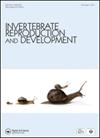The anatomy and histology of the reproductive system of Aplysia oculifera (Mollusca: Heterobranchia: Aplsiida) from the Red Sea coastal waters
IF 0.8
4区 生物学
Q4 REPRODUCTIVE BIOLOGY
引用次数: 0
Abstract
ABSTRACT Aplysia oculifera is an endemic sea hare that inhabits the Egyptian coast of the Red Sea. We describe the reproductive system of this species for the first time. It is composed of an ovotestis, small hermaphroditic duct, nidamental glandular complex, large hermaphroditic duct, gametolytic gland, external seminal groove and cephalic penis. The follicles within the ovotestis contain spermatogenic and oogenic cells. A pre-ampulla, ampulla, and post-ampulla constitute the different regions of the small hermaphroditic duct. The nidamental complex consists of albumen, mucus, and membrane glands all confluent with the fertilization chamber. The nidamental glands consist of glandular cells alternating with supporting cells. The glandular cells have different histochemical characters concerning the production of acid and neutral mucopolysaccharides. The large hermaphroditic duct is attached to a seminal receptacle. The duct has two components; red and white hemiducts the secretory epithelia of which are distinguished internally. An atrial gland is present near the visceral genital opening. The gametolytic gland has four types of columnar cells. A seminal groove arises from the genital opening and extends anteriorly to the apex of an ear-like flap penis. The results suggest that some differences in certain reproductive characters may be of phylogenetic importance.红海沿岸海兔生殖系统的解剖学和组织学研究
摘要眼海兔是一种特有的海兔,栖息在红海的埃及海岸。我们第一次描述了这个物种的生殖系统。它由卵睾丸、小两性导管、生殖腺复合体、大两性导管、配子体腺、外精沟和头状阴茎组成。卵睾丸内的卵泡含有生精细胞和卵子细胞。壶腹前、壶腹和壶腹后构成了两性小导管的不同区域。生殖复合体由蛋白、粘液和膜腺组成,所有这些都与受精室汇合。硝腺由腺细胞和支持细胞交替组成。腺细胞在产生酸性和中性粘多糖方面具有不同的组织化学特征。巨大的两性导管连接在精液容器上。风管有两个部件;红色和白色的半导管,其分泌上皮在内部是有区别的。心房腺存在于内脏生殖器开口附近。配子体腺有四种类型的柱状细胞。生殖道开口处有一个精沟,向前延伸到耳朵状皮瓣阴茎的顶端。结果表明,某些生殖特征的某些差异可能具有系统发育的重要性。
本文章由计算机程序翻译,如有差异,请以英文原文为准。
求助全文
约1分钟内获得全文
求助全文
来源期刊
CiteScore
1.90
自引率
0.00%
发文量
21
审稿时长
>12 weeks
期刊介绍:
Invertebrate Reproduction & Development ( IRD) presents original research on the reproductive and developmental biology of the Invertebrata, both embryonic and postembryonic. IRD welcomes papers reporting significant results obtained using new techniques. Encouraged topic areas include: aquaculture, physiology, biochemistry, functional morphology, phylogeny, behavioural and regulatory mechanisms, including genetic, endocrine and molecular studies. Papers containing qualitative descriptions of reproductive cycles and gametogenesis will not be considered. IRD is published in association with the International Society of Invertebrate Reproduction and Development.

 求助内容:
求助内容: 应助结果提醒方式:
应助结果提醒方式:


